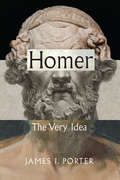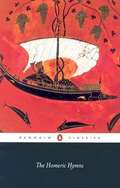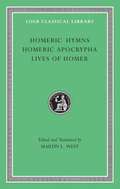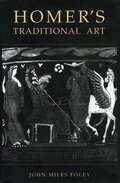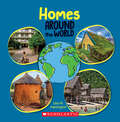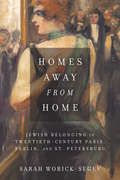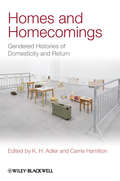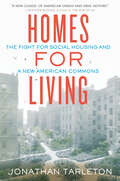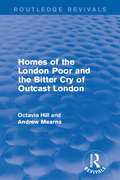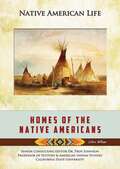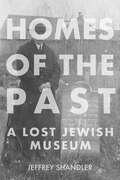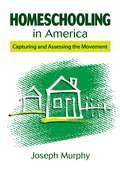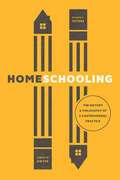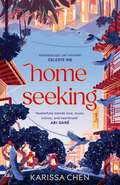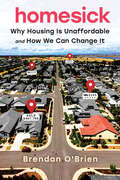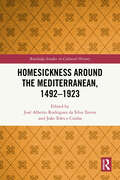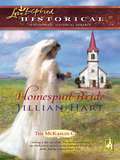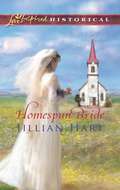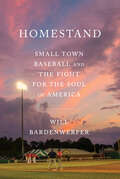- Table View
- List View
Homer: The Very Idea
by James I. PorterThe story of our ongoing fascination with Homer, the man and the myth. Homer, the great poet of the Iliad and the Odyssey, is revered as a cultural icon of antiquity and a figure of lasting influence. But his identity is shrouded in questions about who he was, when he lived, and whether he was an actual person, a myth, or merely a shared idea. Rather than attempting to solve the mystery of this character, James I. Porter explores the sources of Homer’s mystique and their impact since the first recorded mentions of Homer in ancient Greece. Homer: The Very Idea considers Homer not as a man, but as a cultural invention nearly as distinctive and important as the poems attributed to him, following the cultural history of an idea and of the obsession that is reborn every time Homer is imagined. Offering novel readings of texts and objects, the book follows the very idea of Homer from his earliest mentions to his most recent imaginings in literature, criticism, philosophy, visual art, and classical archaeology.
Homeric Hymns
by Nicholas Richardson Jules CashfordThere is a growing awareness about Homeric Hymns--both of their poetic value and also of their significance in the development of archaic Greek religious thought. This translation gives the general reader the opportunity of sharing in the appreciation and enjoyment of their beauty.
Homeric Hymns
by Susan C. ShelmerdineThe Homeric Hymns are a rich source of information for Greek myth, religion, language and culture. But they are more than merely scraps of ancient texts to be mined for material of interest to scholars. Long neglected in favor of the great Homeric epics to which they have been connected by name and tradition since antiquity, these poems also tell stories worth reading in their own right.
Homeric Hymns, Homeric Apocrypha, Lives Of Homer
by Martin L. WestThe Hymns range widely in length: two are over 500 lines long; several run only a half dozen lines. Among the longest are the hymn To Demeter, which tells the foundational story of the Eleusinian Mysteries; and To Hermes, distinctive in being amusing. The comic poems gathered as Homeric Apocrypha include Margites, the Battle of Frogs and Mice, and, for the first time in English, a fragment of a perhaps earlier poem of the same type called Battle of the Weasel and the Mice. The edition of Lives of Homer contains The Contest of Homer and Hesiod and nine other biographical accounts, translated into English for the first time. Martin West's faithful and pleasing translations are fully annotated; his freshly edited texts offer new solutions to a number of textual puzzles.
Homer’s Traditional Art (G - Reference, Information and Interdisciplinary Subjects)
by John Miles FoleyIn recent decades, the evidence for an oral epic tradition in ancient Greece has grown enormously along with our ever-increasing awareness of worldwide oral traditions. John Foley here examines the artistic implications that oral tradition holds for the understanding of the Iliad and Odyssey in order to establish a context for their original performance and modern-day reception.In Homer's Traditional Art, Foley addresses three crucially interlocking areas that lead us to a fuller appreciation of the Homeric poems. He first explores the reality of Homer as their actual author, examining historical and comparative evidence to propose that "Homer" is a legendary and anthropomorphic figure rather than a real-life author. He next presents the poetic tradition as a specialized and highly resonant language bristling with idiomatic implication. Finally, he looks at Homer's overall artistic achievement, showing that it is best evaluated via a poetics aimed specifically at works that emerge from oral tradition.Along the way, Foley offers new perspectives on such topics as characterization and personal interaction in the epics, the nature of Penelope's heroism, the implications of feasting and lament, and the problematic ending of the Odyssey. His comparative references to the South Slavic oral epic open up new vistas on Homer's language, narrative patterning, and identity.Homer's Traditional Art represents a disentangling of the interwoven strands of orality, textuality, and verbal art. It shows how we can learn to appreciate how Homer's art succeeds not in spite of the oral tradition in which it was composed but rather through its unique agency.
Homes Around the World (Around the World)
by Lisa M. HerringtonDiscover countries, cultures, and traditions in this new series!Every day, all around the world, kids go to school, eat lunch and play games... And yet, these universal experiences, can look very different between different countries. These books will take our readers on a trip around the globe to celebrate diverse cultures and traditions, and will show us how different (and how similar) we all are!
Homes Away from Home: Jewish Belonging in Twentieth-Century Paris, Berlin, and St. Petersburg (Stanford Studies in Jewish History and Culture)
by Sarah Wobick-SegevHow did Jews go from lives organized by synagogues, shul, and mikvehs to lives that—if explicitly Jewish at all—were conducted in Hillel houses, JCCs, Katz's, and even Chabad? In pre-emancipation Europe, most Jews followed Jewish law most of the time, but by the turn of the twentieth century, a new secular Jewish identity had begun to take shape. Homes Away From Home tells the story of Ashkenazi Jews as they made their way in European society in the late nineteenth and twentieth centuries, focusing on the Jewish communities of Paris, Berlin, and St. Petersburg. At a time of growing political enfranchisement for Jews within European nations, membership in the official Jewish community became increasingly optional, and Jews in turn created spaces and programs to meet new social needs. The contexts of Jewish life expanded beyond the confines of "traditional" Jewish spaces into sites of consumption and leisure, sometimes to the consternation of Jewish authorities. Sarah Wobick-Segev argues that the social practices that developed between 1890 and the 1930s—such as celebrating holydays at hotels and restaurants, or sending children to summer camp—fundamentally reshaped Jewish community, redefining and extending the boundaries of where Jewishness happened.
Homes and Homecomings: Gendered Histories of Domesticity and Return (Gender and History Special Issues #7)
by K. H. Adler Carrie HamiltonIn Homes and Homecomings an international group of scholars provide inspiring new historical perspectives on the politics of homes and homecomings. Using innovative methodological and theoretical approaches, the book examines case studies from Africa, Asia, the Americas and Europe. Provides inspiring new historical perspectives on the politics of homes and homecomings Takes an historical approach to a subject area that is surprisingly little historicised Features original research from a group of international scholars The book has an international approach that focuses on Africa, Asia, the Americas and East and West Europe Contains original illustrations of homes in a variety of historical contexts
Homes for Living: The Fight for Social Housing and a New American Commons
by Jonathan TarletonA tale of 2 NYC affordable housing co-ops&’ struggle over privatization, public goods, and the future of American housingThe American Dream of homeownership is becoming an American Delusion. As renters seek an escape from record-breaking rent hikes, first-time buyers find that skyrocketing interest rates and historically low inventory leave them with scant options for an affordable place to live. With home valued more than ever as a commodity, even social housing programs meant to insulate families from cut-throat markets are under threat—sometimes by residents themselves.In Homes for Living, urban planner and oral historian Jonathan Tarleton introduces readers to 2 social housing co-ops in Brooklyn and Manhattan. Longtime residents of St. James Towers and Southbridge Towers lock horns over whether to maintain the rules that have kept their homes affordable for decades or to cash out at great personal profit, thereby denying future generations the same opportunity to build thriving communities rooted in mutual care.With a deft hand for mapping personal histories atop the greater housing crisis, Tarleton explores housing as a public good, movements for tenant rights and Indigenous sovereignty, and questions of race and class to lay bare competing visions of what ownership means, what homes are for, and what neighbors owe each other.
Homes of the London Poor and the Bitter Cry of Outcast London (Routledge Revivals)
by Octavia Hill Andrew MearnsOriginally published together in 1970, this study collects two essays on the housing situation of London in the nineteenth century. Homes of the London Poor was first published in 1875 and written by Octavia Hill, the granddaughter of the pioneer of sanitary reformation, Dr. T. Southwood Smith. Influenced by his work and by Christian socialism, she aims to outline the housing problems in London present in her lifetime and how reformation could help those in need of affordable and sanitary housing. The second text comes from a pamphlet written by Andrew Mearns in 1883 which highlights the overcrowded and unsanitary housing conditions that were still a major issue eight years after Hill’s work was published. Both works together present a clear picture of the appalling conditions the poor and homeless were forced into in Victorian London. This title will be of interest to students of history and social work.
Homes of the Native Americans (Native American Life #15)
by Colleen WilliamsAfter Christopher Columbus and other European adventurers landed in the Americas during the 15th and 16th centuries, the lands they explored were often called the "New World." However, North, South, and Central America were new only to the people of Europe. Native Americans had lived on the land for millions of years.In some cases, the natives and Europeans were able to live in peace and even learned from each other. Most of the time, however, the European invaders brought with them disease and violence, which spelled the end of the Native Americans' way of life.
Homes of the Past: A Lost Jewish Museum (The Modern Jewish Experience)
by Jeffrey ShandlerHomes of the Past tells the powerful story of how immigrant Jewish scholars in 1940s New York sought to build a museum to commemorate their lost worlds and people. Among the Jews who arrived in the United States in the early 1940s were a small number of Polish scholars who had devoted their professional lives to the study of Europe's Yiddish-speaking Jews at the YIVO Institute for Jewish Research. Faced with the devastating knowledge that returning to their former homes and resuming their scholarly work there was no longer viable, they sought to address their profound sense of loss by continuing their work, under radically different circumstances, to document the European Jewish lives, places, and ways of living that were being destroyed. In pursuing this daunting agenda, they made a remarkable decision: they would create a museum to memorialize East European Jewry and educate American Jews about this legacy. YIVO scholars determinedly pursued this undertaking for several years, publicizing the initiative and collecting materials to exhibit. However, the Museum of the Homes of the Past was abandoned shortly after the war ended.With insight and clarity, Jeffrey Shandler draws upon the surviving archival sources to tell the story of the purpose, development, and ultimate fate of the Museum of the Homes of the Past.Homes of the Past explores this largely unknown episode of modern Jewish history and museum history and demonstrates that the project, even though it was never realized, marked a critical inflection point in the dynamic interrelations between Jews in America and Eastern Europe.
Homes: A Refugee Story
by Abu Bakr al Rabeeah Winnie YeungIn 2010, the al Rabeeah family left their home in Iraq in hope of a safer life. They moved to Homs, in Syria – just before the Syrian civil war broke out. Abu Bakr, one of eight children, was ten years old when the violence began on the streets around him: car bombings, attacks on his mosque and school, firebombs late at night. Homes tells of the strange juxtapositions of growing up in a war zone: horrific, unimaginable events punctuated by normalcy – soccer, cousins, video games, friends. Homes is the remarkable true story of how a young boy emerged from a war zone – and found safety in Canada – with a passion for sharing his story and telling the world what is truly happening in Syria. As told to her by Abu Bakr al Rabeeah, writer Winnie Yeung has crafted a heartbreaking, hopeful, and urgently necessary book that provides a window into understanding Syria.
Homeschooling in America: Capturing and Assessing the Movement
by Joseph MurphyThis revealing and balanced portrait of homeschooling today provides a full history of the movement, demographic insights, and extensive research on how homeschooled children fare in the United States. Delving into a movement that impacts more students nationwide than the entire charter school movement, this book explores: The history of homeschooling in America How this movement has grown in credibility and enrollment exponentially The current state of homeschooling, including questions about who gets homeschooled, why, and what is the success-academically and in life-of students who are homeschooled The impact of homeschooling on the student and on American societyIn 2010, more than two million students were homeschooled. In the most extensive survey and analysis of research on homeschooling, spanning the birth of the movement in the 1970s to today, Homeschooling in America shines a light on one of the most important yet least understood social movements of the last forty years and explores what it means for education today.
Homeschooling the Right: How Conservative Education Activism Erodes the State
by Professor Heath BrownFor four decades, the number of conservative parents who homeschool their children has risen. But unlike others who teach at home, conservative homeschool families and organizations have amassed an army of living-room educators ready to defend their right to instruct their children as they wish, free from government intrusion. Through intensive but often hidden organizing, homeschoolers have struck fear into state legislators, laying the foundations for Republican electoral success.In Homeschooling the Right, the political scientist Heath Brown provides a novel analysis of the homeschooling movement and its central role in conservative efforts to shrink the public sector. He traces the aftereffects of the passage of state homeschool policies in the 1980s and the results of ongoing conservative education activism on the broader political landscape, including the campaigns of George W. Bush and the rise of the Tea Party. Brown finds that by opting out of public education services in favor of at-home provision, homeschoolers have furthered conservative goals of reducing the size and influence of government. He applies the theory of policy feedback—how public-policy choices determine subsequent politics—to demonstrate the effects of educational activism for other conservative goals such as gun rights, which are similarly framed as matters of liberty and freedom. Drawing on decades of county data, dozens of original interviews, and original archives of formal and informal homeschool organizations, this book is a groundbreaking investigation of the politics of the conservative homeschooling movement.
Homeschooling: The History & Philosophy of a Controversial Practice (History and Philosophy of Education Series)
by James G. DwyerIn Homeschooling: The History and Philosophy of a Controversial Practice, James G. Dwyer and Shawn F. Peters examine homeschooling’s history, its methods, and the fundamental questions at the root of the heated debate over whether and how the state should oversee and regulate it. The authors trace the evolution of homeschooling and the law relating to it from before America’s founding to the present day. In the process they analyze the many arguments made for and against it, and set them in the context of larger questions about school and education. They then tackle the question of regulation, and they do so within a rigorous moral framework, one that is constructed from a clear-eyed assessment of what rights and duties children, parents, and the state each possess. Viewing the question through that lens allows Dwyer and Peters to even-handedly evaluate the competing arguments and ultimately generate policy prescriptions. Homeschooling is the definitive study of a vexed question, one that ultimately affects all citizens, regardless of their educational background.
Homeseeking: An epic tale of one couple spanning decades as world events pull them together and apart
by Karissa Chen'A layered, beautifully written, and deeply moving novel. Karissa Chen masterfully blends love, music, history, and heartbreak to create a sweeping tale that spans decades and continents' - Abi Daré'[Homeseeking] weaves expertly between present and past, telling the story of childhood sweethearts who meet again late in life and are torn between looking back and moving on' - Celeste Ng'A love story in more ways than one, Homeseeking is a beautiful, nuanced look at Chinese history, family, young love, and the wisdom of age' - Vanessa ChanThere are moments when a single choice can define an entire life. Haiwen and Suchi are teenage sweethearts in 1940s Shanghai; their childhood friendship has blossomed into young love, and they believe that they are soulmates. But when Haiwen secretly decides to enlist in the army to keep his brother from the draft, their shared future is shattered. Their paths take them far afield from each other, with the exception of one pivotal chance encounter on the Hong Kong ferry in 1966. Sixty years later, Haiwen, now in his late seventies, is bagging bananas at a 99 Ranch in Los Angeles when he lifts his head to once more see Suchi. As they begin to rekindle their friendship, it feels like they might have a second chance to live the life they were supposed to have together. But the weight of the past lives with them at every moment, and only time will tell if they are able to forge something new. Told in alternating narratives, Homeseeking spans seven decades, through the most tumultuous period of modern Chinese history up to contemporary times, tracing the separated lovers as they migrate from Shanghai to Hong Kong, Taiwan, and America.
Homeseeking: An epic tale of one couple spanning decades as world events pull them together and apart
by Karissa Chen'A layered, beautifully written, and deeply moving novel. Karissa Chen masterfully blends love, music, history, and heartbreak to create a sweeping tale that spans decades and continents' - Abi Daré'[Homeseeking] weaves expertly between present and past, telling the story of childhood sweethearts who meet again late in life and are torn between looking back and moving on' - Celeste Ng'A love story in more ways than one, Homeseeking is a beautiful, nuanced look at Chinese history, family, young love, and the wisdom of age' - Vanessa ChanThere are moments when a single choice can define an entire life. Haiwen and Suchi are teenage sweethearts in 1940s Shanghai; their childhood friendship has blossomed into young love, and they believe that they are soulmates. But when Haiwen secretly decides to enlist in the army to keep his brother from the draft, their shared future is shattered. Their paths take them far afield from each other, with the exception of one pivotal chance encounter on the Hong Kong ferry in 1966. Sixty years later, Haiwen, now in his late seventies, is bagging bananas at a 99 Ranch in Los Angeles when he lifts his head to once more see Suchi. As they begin to rekindle their friendship, it feels like they might have a second chance to live the life they were supposed to have together. But the weight of the past lives with them at every moment, and only time will tell if they are able to forge something new. Told in alternating narratives, Homeseeking spans seven decades, through the most tumultuous period of modern Chinese history up to contemporary times, tracing the separated lovers as they migrate from Shanghai to Hong Kong, Taiwan, and America.
Homesick: Why Housing Is Unaffordable and How We Can Change It
by Brendan O'BrienNobody who sits in traffic on Sedona, Arizona's main stretch or stands shoulder-to-shoulder in its many souvenir shops would call it a ghost town. Neither would anyone renting a room for $2,000 a month or buying a house for a half-million dollars. And yet the people who built this small town and made it a community are being pushed further and further out. Their home is being sold out from under their feet. In studying the impact of short-term rentals, Brendan O'Brien saw something similar happening in places ranging from Bend, Oregon, to Bar Harbor, Maine. But it isn't just short-term rentals, and it's not just tourism towns. Neighborhoods in Austin and Atlanta have become rows of investment properties. Longtime residents in Spokane and Boston have been replaced by new, high-salaried remote workers. Across the country, a level of unaffordable housing that once seemed unique to global cities like New York and San Francisco has become the norm, with nearly a third of all US households considered housing cost burdened. This situation has been abetted by the direct actions of developers, politicians, and existing homeowners who have sought to drive up the cost of housing. But it's mostly happened due to a society-wide refusal to see housing as anything more than real estate, another product available to the highest bidder. This trend of putting local housing on a global market has worsened in recent years but is nothing new. Housing in the United States has always been marred by racial and income inequality that mocks the country's highest ideals.Deeply researched and deeply felt, Homesick argues that we can be so much better. And we can start where we live.
Homesickness
by Carlos RojasCarlos Rojas focuses on the trope of "homesickness" in China--discomfort caused not by a longing for home but by excessive proximity to it. This inverse homesickness marks a process of movement away from the home, conceived of as spaces associated with the nation, family, and individual body, and gives rise to the possibility of long-term health.
Homesickness around the Mediterranean, 1492–1923 (Routledge Studies in Cultural History)
by José Alberto Rodrigues da Silva Tavim João Teles e CunhaThis volume analyzes how people of diverse cultural and religious backgrounds living around the “Middle Sea” perceived, felt, and described homesickness, using a multidisciplinary approach which brings new perspectives to known phenomena and their evolving meanings.The sixteen chapters in this book span the fields of history, literary and cultural studies, and musicology to explore and revisit old and new subjects including diasporas, renegades, expatriates, travelogues, testaments, inquisitorial processes, songbooks, movies, and photos. Together, they provide a comprehensive picture of homesickness across states, cultures, religions, and people, furthering understanding of how individuals, communities, and nations created and expressed images, ideas, and emotions on this subject. Though centered around the Mediterranean, this volume also studies the impact of homesickness in a larger geography touched by the Iberian empires.This important contribution to the history of emotions offers studies on subjects seldom available in the English-speaking world and will appeal to undergraduates, postgraduates, scholars, and non-specialists alike.
Homespun Bride
by Jillian HartMontana Territory in 1883 was a dangerous place--especially for a blind woman struggling to make her way through an early winter snowstorm. Undaunted, Noelle Kramer fought to remain independent. But then a runaway horse nearly plunged her into a rushing, ice-choked river, before a stranger's strong, sure hand saved her from certain death. And yet this was no stranger. Though she could not know it, her rescuer was rancher Thad McKaslin, the man who had once loved her more than life itself. Losing her had shaken all his most deeply held beliefs. Now he wondered if the return of this strong woman was a sign that somehow he could find his way home.
Homespun Bride
by Jillian HartMontana Territory in 1883 was a dangerous place--especially for a blind woman struggling to make her way through an early winter snowstorm. Undaunted, Noelle Kramer fought to remain independent. But then a runaway horse nearly plunged her into a rushing, ice-choked river, before a stranger's strong, sure hand saved her from certain death. And yet this was no stranger. Though she could not know it, her rescuer was rancher Thad McKaslin, the man who had once loved her more than life itself. Losing her had shaken all his most deeply held beliefs. Now he wondered if the return of this strong woman was a sign that somehow he could find his way home.
Homespun Bride & The Briton: Homespun Bride\The Briton
by Catherine Palmer Jillian HartTwo loyal protectors across the agesHomespun BrideMontana Territory in 1883 was a dangerous place—especially for a blind woman struggling through a snowstorm. When a runaway horse nearly plunged Noelle Kramer into an ice-choked river, a stranger’s sure hand saved her from certain death. Her rescuer was rancher Thad McKaslin, the man who had once loved her more than life itself. Perhaps the return of Noelle was a sign that somehow he would find his way home.The BritonLady Bronwen, proud inheritor of the ancient ways of the Britons, had lost everything. Widowed in war, robbed of her ancestral home, she knew her last hope was a stranger with whom she’d shared a single kiss. Jacques le Brun wanted nothing more than to protect her. But he owed fealty to the French, and the new faith they brought with them to England. Could Bronwen place her trust in this knight and follow him to a new world?
Homestand: Small Town Baseball and the Fight for the Soul of America
by Will BardenwerperA poignant memoir exploring small town baseball as a lens into what&’s right and wrong with modern America—written by an acclaimed journalist and Army Ranger who, after returning from Iraq to a painfully divided country, rediscovered its core values in the bleachers of a minor league ballpark in Batavia, New York.What happens when a minor league team—the heart and soul of a Rust Belt town in western New York—is shut down by the billionaires who run Major League Baseball?Batavia, New York—between Rochester and Buffalo—hosted its first professional baseball game in 1897. Despite decades of deindustrialization and evaporating middle-class jobs, the Batavia Muckdogs endured. When Major League Baseball cravenly shut them down in 2020—along with forty-one other minor league teams—the town fought back, reviving the Muckdogs as a summer league team comprised of college players. As MLB considers further cuts and private equity buys up what remains, the mom-and-pop operations once prevalent in baseball are endangered. But for now, the sights and sounds of local baseball live on in Batavia—cheap draft beer and hot dogs, starry-eyed kids seeking autographs, and breathtaking summer sunsets.With a vibrant, unforgettable cast of characters—from a librarian and her best friend whose relationship deepens with every &“crepuscular hour&” they spend together in the bleachers, to the former hockey brawler-turned team owner who greets regulars while working the concession stand, to the iconoclastic writer with a contagious love for his struggling hometown—Bardenwerper&’s Homestand exposes the beating heart of small town America, friends and neighbors coming together as the crack of the bat echoes in the summer twilight.
